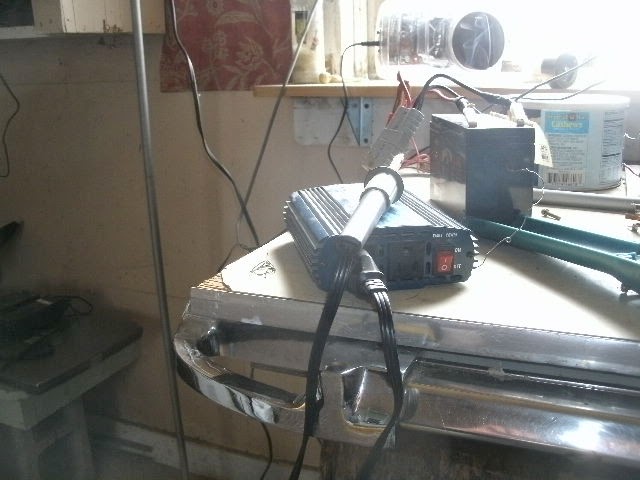This is a work in progress and subject to change as I collect more data expect the addition of links to various examples to be added and probably some remedial editing.
Basic points.
First we must understand that the United States is no longer an industrial nation and as such we do not have the ability to produce or dispose of the devices we use.
Modern industrial and marketing practices are fundamentally counter environmental as they promote shorter and shorter product cycles. As there is no way to produce anything without a waste product More production inevitably leads to more waste.
Electronic “takeback” programs can exacerbate this problem by promoting a “Design to grind” model that does not actually reduce the amount of waste but moves it into other areas of the environmental spectrum.
For example. Current environmental law requires that a fee be charged to handle the disposal of electronic items in California. These funds are used to dispose of material by use of grinding of the items and refining of the raw material, This is laudable in intent but counterproductive in action.
To demonstrate; An electronic device is almost always constructed in an area where wages are low and environmental laws are non-existent or still under development. Examples of this would be China,India, Vietnam,Malaysia,Thailand,etc. Weak environmental practices combined with the fact that most of these are coal fired economies lead to predictable and demonstrable levels of environmental degradation and as pollution does not respect borders is an issue that affects us all, add to this the corporate motivation to sell a new item as often as possible and you find that this leads to the observation that the most environmentally friendly item is probably the one you buy least often.
The environmental issue are compounded when one adds transport to the problem. Maritime transport is among the most toxic aspects of our current production scenario as it is largely unregulated and consumes prodigious amounts of high sulfur fuel. The simple fact is that the more you ship the more waste is produced.
This is only the production end, the disposal end has additional problems and they are as bad if not worse than production and are also potentially made more problematic by current “takeback” methods.
As we are no longer an industrial nation the best that can be reasonably hoped for is some pre-proccessing before the material gets shipped back to coal fired, low wage industrial economies using highly polluting transport.
This is actually an optimistic view as can be demonstrated by the existence of massive toxic waste dumps in Asia, Africa and eastern Europe.
Reclamation/disposal when done correctly is expensive and has small profit margins. This is unfortunately not the case when done incorrectly by the unscrupulous. Massive profits can be made by cutting corners.
In addition our need to buy new materials is actually promoting violence,Child slave labor and the extinction of specie by funding those who would use these methods to generate income. An example would be the horrific sources for the coltan used in some of our most popular devices.
All of these problems could be reduced by reducing consumption through extending product lifespan.
I am not trying to say that we cannot have new devices, only pointing out that we could provide an incentive to the consumer and the manufacturer to make better choices through the existing electronic disposal system.
This could be done by modifying the system to promote lifespan.
First we start with simple things.
Modern video displays/televisions have three primary points of failure. The lighting system, the physical display/screen and the power supply.
Computers/tablets, First the observations listed above apply to notebooks/laptops with the addition of motherboards/memory and storage. Again nothing here is difficult and nothing should require the use of anything more than a simple screwdriver. Desktop computers could be even easier.
Phones, Seemingly obvious things like user replaceable batteries and standard fastenings would be a good place to start.
None of these should ever require more than a screwdriver and simple instructions to replace allowing for repair by the consumer. If we lower the mandated disposal fee for the item we can encourage both the manufacturer and consumer to choose a product that will last longer, costs less in the long run and limit the amount of transport. This reduces the cost to the consumer and the planet as a whole.
As a negative example a major manufacturer of smart phones recently went so far as to replace the screws on its phones with proprietary ones when brought in for repair or replacement of a battery. Thereby holding the consumer hostage to the manufacturer. This is an example of what we should be discouraging with the current system and reflects a predatory design flaw reflected throughout the entire product line. Practices like this should be charged more under the system to reflect the increased environmental costs.
In addition user replaceable components could allow for upgrades to existing hardware allowing for increased lifespan and improving capabilities.
Examples of this might be, replacing florescent lighting in your tv with a bar of Light emitting diodes,replacing the batteries in you cell phone when better technologies become available, etc.
We could also tie the system in with the Maker/Hacker movement through something as a simple as a “User serviceable parts inside!” Sticker on the back. I could be wrong but I think that is a ready to roll add campaign.
Thank you for your consideration.





















































